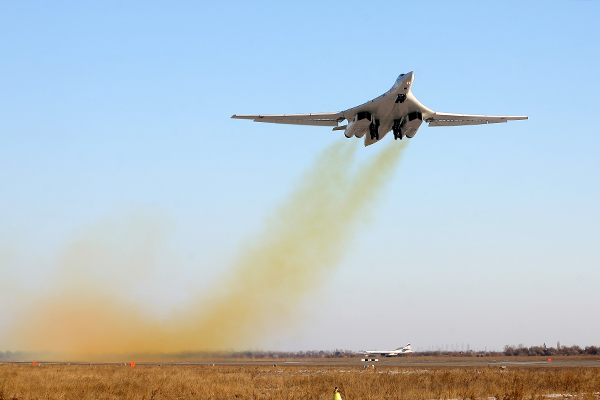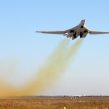
Putin Adjusts Russia’s Syria Strategy
Publication: Eurasia Daily Monitor Volume: 12 Issue: 215
By:

President Vladimir Putin’s decision to militarily intervene in Syria came after long and careful preparations to mitigate the risks of conflict escalation. However, two events complicated Russia’s involvement and demanded a revision of this overall strategy: the Islamic State (IS) attacks in Paris as well Turkey’s downing of the Russian Su-24M that had violated Turkish airspace. Moscow has boosted the number of sorties flown daily against targets in Syria and further strengthened the air and air defense deployments in the country; with these moves, Putin signals his willingness to up the ante and demonstrate commitment to a longer timescale for the Russian air operations (Interfax, December 2; Moskovskiy Komsomolets, November 27; RIA Novosti, November 20).
Putin has ordered the Black Sea Fleet force grouping deployed in the Eastern Mediterranean to cooperate with Russia’s ally—France. Indeed, the aftermath of the November 13 IS attacks in Paris has certainly done much to move France and Russia significantly closer; though the two have hardly reached a genuine alliance to date. Following bilateral Russo-French talks in Moscow on November 26, Putin signaled that military and intelligence cooperation would develop between both countries in their efforts against the Islamic State. Whereas, President François Hollande underscored the sticking point in Russia’s full participation in the international anti-IS coalition: namely, the future role of Syrian President Bashar al-Assad. Nonetheless, both leaders appeared to assume that Russia is already a member of this coalition. In effect, Moscow has bolted itself onto the anti-IS coalition, but under its own terms and conditions (TASS, November 18).
The deadly Paris terrorist attacks proved to be a catalyst for the intensification of the Russian air operations in Syria. Moscow authorized additional cruise missile strikes from naval assets in the Caspian Sea and also by air using strategic bombers flying from airbases in southern Russia. During this intensification phase, Raqqa—the Islamic State’s de facto capital in Syria—was heavily targeted. Some reports suggest Moscow may reduce Raqqa to rubble. Putin and the top brass also spoke at length about targeting IS-held petroleum facilities and tankers purportedly trafficking oil across the Turkish border (Nezavisimoye Voyennoye Obozreniye, November 27).
On November 20, Russian Defense Minister Sergei Shoigu declared that in the previous four days, the Russian air grouping in Syria doubled to 69 aircraft, while the naval grouping now consists of ten ships (four in the Caspian Flotilla and six operating in the Mediterranean Sea). Shoigu stated that cruise missile strikes were carried out from the Mediterranean and Caspian Seas at a range of up to 1500 kilometers, while aviation was used from airfields in Russia and Syria. Strikes were conducted by 29 long-range strategic bombers “from the direction of the Caspian Sea.” Following flights of up to 13,000 kilometers, Tu-160 bombers conducted cruise missile strikes from the Mediterranean Sea. Shoigu summarized the results of this early phase of intensifying the air campaign: “In total, strategic and tactical aviation have completed 522 combat flights, launched 101 air- and sea-launched cruise missiles, and dropped 1,400 tons of bombs of various types. In all, 826 enemy targets have been destroyed. The main effort has been concentrated on the Islamic State’s financial-economic base” (Channel One TV, Rossiya 1 TV, Interfax, November 20).
As President Hollande told his allies in Washington and London, the aim of the French initiative—which presaged the United Nations Security Council resolution against the terrorist organization—is the total destruction of the Islamic State; this was repeated during Hollande’s talks with Putin. Subsequently, the Russian military media returned to discussing the aims and limitations of Moscow’s own air campaign. Alexander Khramchikhin, the deputy director of the Institute of Political and Military Analysis, expressed doubts about the potential of air power to achieve such goals, even if Moscow has the advantage of other forces supplying boots on the ground. Khramchikhin offered an unusual perspective on the organizational structure of the IS that may be influencing Russian military planning. As the author explained, the “Caliphate” has in effect an “army” with its own “troops,” armored vehicles and artillery. In this sense, the author sees the IS as lacking the typical hallmarks of a “guerrilla or terrorist structure. Consequently, Khramchikhin characterizes the campaign against the IS and its affiliates as a “classical war,” rather than an antiterrorism or counterinsurgency operation (VPK, November 25).
While such speculation remained in some of the Russian reporting on the air campaign in Syria, there is no doubt that a complicating factor is that part of the Russian strategy depends on supporting the al-Assad regime precisely because that affords at least a modicum of a ground element in the longer-term campaign. As the Russian Aerospace Forces (Vozdushno Kosmicheskikh Sil—VKS) targeted rebel groups including the so-called “moderate opposition”—a phrase the Russian leadership believes to be an oxymoron—this also involved bombing Turkmen rebels in areas close to the Turkish border. Ankara’s action in shooting down the Russian Su-24M resulted in an outcry in Moscow; and Russia’s swift economic retaliation contains military components. Shoigu addressed a defense ministry collegium in Moscow on November 26, and confirmed the steps undertaken to ensure the safety of VKS assets operating in Syrian airspace. This includes transferring the S-400 surface-to-air missile (SAM) system to the airbase in Latakia, relocating the Moskva (the flagship of the Black Sea Fleet) to provide additional air defense capabilities, offering fighter escorts for VKS assets involved in bombing missions, and, for the first time, arming these with air-to-air missiles. The presence of the S-400 system and Russia electronic warfare systems will further complicate the operational environment for the international coalition (Lenta.ru, November 26; Kommersant, Mil.ru, November 25).
Mikhail Khodarenok, the editor of Voyenno Promyshlennyy Kuryer and a retired Soviet Air Force pilot, raises the important issue of assessing the actual level of the Russian air campaign; In particular, he asks whether these operations are strategic, operational or tactical. After examining Soviet and Russian military approaches to understanding these concepts, Khodarenok recalls a lecture by one of his professors in the Soviet Air Force Academy: “A hair on the head: is it a lot or a little? And in the soup? Probably a lot. Therefore, we need criteria.” Judging by Russia air operations in Syria to date, even after their recent intensification, these remain mostly tactical or operational at best. It seems that Russian media coverage stresses the “hair in the soup” rather than on the head, perhaps reflecting a general “war enthusiasm” in press coverage (VPK, November 25).




